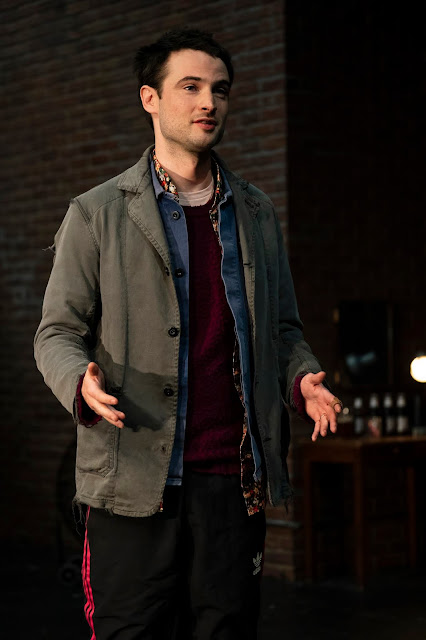"Fathers, Daughters, Sons"

 Tom
Sturridge (Orphans, 1984) and Jake Gyllenhaal (Sunday in the Park with George, Constellations), both exciting leading
men of stage and screen, bring audiences at the Public Theater to their feet at
the end of Sea Wall/A Life, a bill of
back-to-back monologues.
Tom
Sturridge (Orphans, 1984) and Jake Gyllenhaal (Sunday in the Park with George, Constellations), both exciting leading
men of stage and screen, bring audiences at the Public Theater to their feet at
the end of Sea Wall/A Life, a bill of
back-to-back monologues.  |
| Tom Sturridge. Photo: Joan Marcus. |
 |
| Jake Gyllenhaal. Photo: Joan Marcus. |
Simon Stephens’s (The Curious Incident of the Dog in the Night-Time) “Sea Wall” (written in 2008) and Nick Payne’s (If There Is, I Haven't Found It Yet) “A Life,” each around 45-minutes (they’re separated by a 15-minute intermission),
are performed on the same bare, brick-walled, Newman Theater set, designed by
Laura Jellinek and lit by Peter Kaczorowski. A scarcely used upper level runs
across the stage proper, to which it’s connected by a set of stairs, also underused. A piano at right center is used (for a mournful rendition of "Imagine") only at the end of “A Life.”
The British Sturridge and the American Gyllenhaal, directed
by Carrie Cracknell, play ordinary, happily married men, dressed by Kaye Voyce
in basic everyday wear. They tell their stories to no one in particular as
they try to make sense of events both recent and in the past. Only
a small number of other characters figure in their narratives.
Both plays examine fatherhood, marriage, childbirth, and the care of daughters, both move back
and forth in time, both include traumatic events, and both ask existential
questions about the meaning of life. They capture moods and incidents in
natural-sounding, yet poetically suggestive prose, but, while they explore strong
feelings, they possess little dramatic tension.
The “f-word” gets plenty of mileage, especially in “A Life,”
which also—despite the concern it and its partner share with death—manages to
squeeze a few laughs out of its generally serious substance. About the only chuckle
raised by “Sea Wall” comes from Alex’s pride in pronouncing Carquerraine, the
name of a French town.
 |
| Tom Sturridge. Photo: Joan Marcus. |
In "Sea Wall," Sturridge plays Alex, a British photographer trying to maintain
his composure in the wake of a recent tragedy that he gradually reveals. Much
of it concerns his father-in-law, an ex-military man and retired math
teacher who lives in a village in the south of France. There, Alex, his wife,
Helen, and their little girl, Lucy, the apple of her grandpa’s eye, vacation
annually, swimming in the Mediterranean.
As he builds toward the climax of his tale, Alex describes
his conversations with his father-in-law about the existence of God, a subject about
which they politely disagree and that remains a persistent thread to which Alex
keeps returning. But, regardless of the grief that would seem the trigger for
his story, he continues weaving into it trivia on various subjects, from scuba
diving to photography to detective fiction.
He pays considerable attention to the circumstances of Lucy’s
birth, but also describes moments incidental to her getting older and the love
she generates. All this is a buildup to the heart-rending event that concludes Alex’s
sometimes elegiac rambling and the expression of his hope that we’ll one day
understand why such things happen. Nonetheless, for all its assumed depth, “Sea
Wall” really doesn’t dive very deeply at all.
 |
| Jake Gyllenhaal. Photo: Joan Marcus. |
In “A Life,” Gyllenhaal is Abe, and his story also devotes
much time to the physical circumstances of his child’s birth, as well as to its
aftermath. But it also keeps shifting to his own beloved father and the fatal heart
disease that struck him when Abe was a teen.
Whereas Sturridge’s Alex has a modicum of physical freedom, the
stage is darkened for Abe’s narrative, isolating him in a spotlight, like a
stand-up comic. Perhaps because the director grew bored of him standing in one
spot for so long, she has him rush through the audience at one point, with his
cell phone flashlight on, before returning to the stage.
Payne’s script is technically more complex than Stephens’s
since it is essentially two stories running on parallel tracks. One is the preparation
for Abe’s baby’s birth, the birth itself, and its postnatal care. The second
concerns Abe’s father’s ailment, death, and—with a message about how much we
prepare for birth and how little for death—what came after. Tying the tracks
together is Abe’s preoccupation with his lack of confidence in his own
fatherhood, and the experience that shows him otherwise.
The play could as easily have been called, “A Life; A Death”;
it once was called “The Art of Dying.” Gyllenhaal is required to make rapid
shifts in dialogue to suggest different speakers as well as overlapping chronicles.
The nature of the material, however, prevents him from showboating and, all things
considered, he renders a rather restrained, yet always truthful, almost
conversational performance.
Fans of Sturridge and Gyllenhaal will appreciate the chance
to see these stars in the flesh, with eyes trained on only them. But I would
have preferred to have had the distraction of, at the least, dramatic action and other
actors for these fine actors to play off.
Public Theater/Newman Theater
425 Lafayette Avenue, NYC
Through March 31
OTHER VIEWPOINTS:
